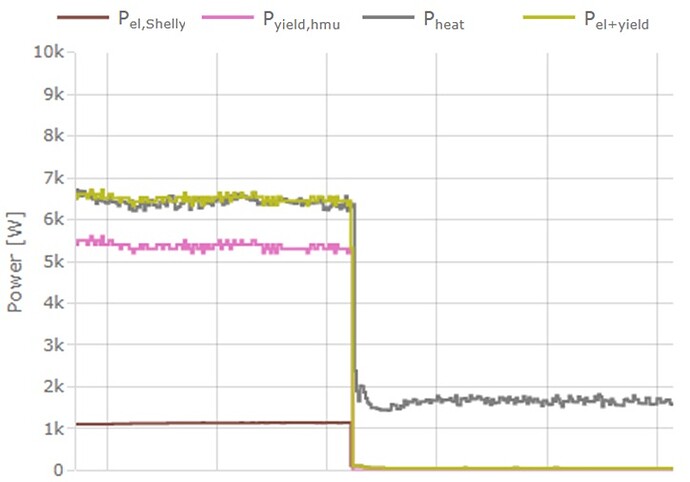I have a freshly installed Arotherm plus 105/6 with a VWZ MEH 97/6 hydraulic station and did quite some investigations regarding the built-in monitoring that I would like to share. First some notes on my hardware setup:
I am reading the eBUS data using ebusd and an Esera USB ebus coupler (eBus Heizung Koppler & Gateways) plugged into a Raspberry Pi using this csv config to decode the data: eigene CSV erstellen und einbinden · john30/ebusd · Discussion #720 · GitHub. It is then being sent to my MQTT broker. I am polling the following measurements every 10 seconds:
ebusd/hmu/CurrentYieldPower - Current vaillant “Environmental yield” power
ebusd/hmu/CurrentConsumedPower - Current electrical power
ebusd/hmu/WaterThroughput - Water flow rate
ebusd/hmu/FlowTemp - Flow temperature
ebusd/hmu/ReturnTemp - Return temperature
I am also measuring the electrical power using a Shelly Pro 3EM; albeit this is for the whole installation. I also installed external temperature sensors on the flow and return pipes (PT100 + MAX31865, manually calibrated in a water bath between 0-100°C to yield zero relative temperature difference).
Using the eBUS values for flow rate, flow and return temperature I calculate the heat power. I also calculate this using the reported flow rate and my own external temperature probes. The eBus queried values (i.e. provided by Vaillant) are piped into emoncms: Emoncms - app view
Here are my observations:
-
Vaillant reported electrical power very closely matches my Shelly measurements. As the power by Vaillant is reported in kW with only 0.1kW increments, I’m using my shelly data instead.
-
The Vaillant “Environmental Yield” power very closely matches the result I get when I calculate heat power using flow rate and (flow-return) temperature and then subtracting electrical power. Most likely this is exactly what they are doing internally. Here’s a graph showing the Shelly electrical measurement (P_el,shelly), reported Yield power (P_yield,hmu), my own calculated heat power (P_heat) and the sum of yield + electrical power. It matches exteremely well. Integrating this yield power over the day gives almost exactly the same value as the Vaillant reported environmental yield energy that can be read off the VWZ device display.
- The graph shows a segment at the end of a heating cycle where we can see behaviour between on- and off state of the heat pump compressor. You will notice that electrical power and yield power drop to essentially zero, but my own calculated heat power does not. Why is that? - That’s because even when the heat pump is off there is a reported deltaT between flow and return of about 1.2K. This should not be there as there is no power input to the system. Flow and return should be at the same temperature and slowly decay at the same rate. As a matter of fact, my own temperature probe measurements show exactly this, as can be seen in the following graph. Where my own PT100 flow + return measurements drop to the same level when the compressor is off (and this temperature closely aligns with the Vaillant reported value), the Vaillant reported flow temperature stays around 1.2K above the return temperature. As a matter of fact, this offset is also visible during operation when the Vaillant flow temperature reports around 1.2K above my own measurement. I do trust my own probes more since what they are measuring makes sense from a physics perspective; and the return measurements exactly align with Vaillants measurement.
This 1.2K difference coupled with my 1600 l/h flow rate translates to a whopping 2.2 kW overestimation of heating power by Vaillant, which in turn results in a much overreported environmental yield and exaggerated COP.
Further evidence for overestimation of heat power:
We recently had a -10°C average day and I had a flow temperature at around 35°C (hooray for 140mm fans under the radiators!). According to the Vaillant specs, I should get a COP of around 3. The measured COP is 4 - which while I would really like but won’t believe for one second. The same figure is reported by the myVaillant app.
Furthermore I know the heat power requirements of my house very well. In preparation for the heat pump installation I monitored gas consumption using an impulse counter last year and correlated gas usage with outdoor temperature. Over the last heating season I found that I need 3.75 kWh per day for every Kelvin difference between inside temperature (20°C) and outside temperature - and that was with an inefficient 30-year old gas heating system. Using Vaillants reported heat power measures I get nowhere close to that but always significantly higher. I would expect something lower since I’m at much lower flow temperatures, the system is better insulated and does not dump a lot of heat into smoke and my heating room. For the aforementioned -10°C day, I’m getting 4 kWh / K based on the Vaillant data - which is too high. I have essentially never seen a value < 4 kWh/K which I find highly suspect and which led me down this rabbit hole in the first place.
This is either a defect on my pump - which can be fixed as it is still under warranty, or a systematic way to overinflate COP measurements…(of course the app states that the reported values are calculated and can be significantly off).
My question is: Can anyone confirm this behaviour? Are your reported flow and return temperatures also significantly apart even when the compressor is off? How well do they match your own measurements?

